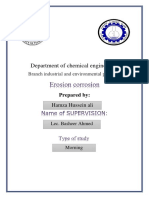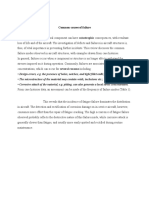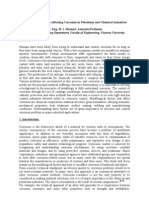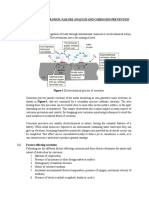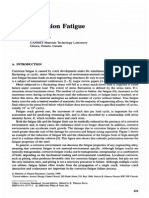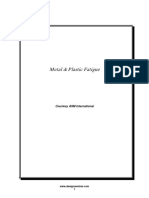Unit 5 Fatigue and Fracture
Unit 5 Fatigue and Fracture
Uploaded by
ShivaCopyright:
Available Formats
Unit 5 Fatigue and Fracture
Unit 5 Fatigue and Fracture
Uploaded by
ShivaOriginal Description:
Original Title
Copyright
Available Formats
Share this document
Did you find this document useful?
Is this content inappropriate?
Copyright:
Available Formats
Unit 5 Fatigue and Fracture
Unit 5 Fatigue and Fracture
Uploaded by
ShivaCopyright:
Available Formats
AE 2030 FATIGUE AND FRACTURE - 2014
UNIT-5
FUNDAMENTALS OF FAILURE ANALYSIS
Common causes of failure, Principles of failure analysis. Fracture mechanics approach to failure
problems. Techniques of failure analysis. Service failure mechanisms - ductile and brittle
fracture, fatigue fracture, wear failures, fretting failures, environment induced failures, high
temp. failure. Faulty heat treatment and design failures, processing failures
(forging, casting, machining etc.),
Common causes of failure
Failure of an aircraft structural component can have catastrophic consequences, with resultant
loss of life and of the aircraft. The investigation of defects and failures in aircraft structures is,
thus, of vital importance in preventing further incidents. This review discusses the common
failure modes observed in aircraft structures, with examples drawn from case histories.
What causes failure?
In general, failures occur when a component or structure is no longer able to withstand the
stresses imposed on it during operation. Commonly, failures are associated with stress
concentrations, which can occur for several reasons including:
Design errors, e.g. the presence of holes, notches, and tight fillet radii;
The microstructure of the material may contain voids, inclusions etc.;
Corrosive attack of the material, e.g. pitting, can also generate a local stress concentration.
From case histories data, an assessment can be made of the frequency of failure modes (Table 1).
Table
Corrosion 29 16
Creep 3 -
T.Manikandan, Asst Professor, Aeronautical Engg Dept, Jeppiaar Engg College, Chennai-119
Page 1
AE 2030 FATIGUE AND FRACTURE - 2014
Wear/abrasion/erosion 3 6This
reveals that the incidence of fatigue failure dominates the distribution in
aircraft. The detection and rectification of corrosion damage on in-service aircraft, however,
consumes more effort than the repair of fatigue cracking. The high occurrence of fatigue failure
observed probably reflects the destructive nature of this failure mode, while corrosive attack is
generally slower than fatigue, and usually more easily spotted and rectified during routine
maintenance.
Common failure modes
Fatigue is a process whereby cracking occurs under the influence of repeated or cyclic
stresses, which are normally substantially below the nominal yield strength of the material.
Components that fail by fatigue usually undergo three separate stages of crack growth, which are
described as follows:
Initiation of a fatigue crack. This can be influenced by stress concentrations such as
material defects or design.
Propagation of the fatigue crack. This is progressive cyclic growth of the crack.
Final sudden failure. Eventually, the propagating crack reaches a critical size at which the
remaining material cannot support the applied loads and sudden rupture occurs.
Fatigue fractures tend to be relatively smooth near the origin and show slight roughening of the
surface as the crack progresses. There tends to be little or no macroscopic ductility associated
with fatigue cracking. Detailed examination of the fracture surface in a scanning electron
microscope (SEM) usually shows evidence of fatigue striations (dependant on the material),
which represent one cycle of load and crack propagation. If the magnitude of load cycle remains
constant, the striations normally appear closer near the origin, gradually increasing in spacing as
the crack front progresses due to the increasing stress at the crack tip.
Fatigue cracking is the most common cause of structural failure in aircraft, Materials and their
design can be taken into consideration so that the probability of fatigue cracks occurring can be
reduced, but it is often the case that the possibility cannot be removed completely. Therefore
many aircraft structural components are designed with a safe or inspection-free life, below which
T.Manikandan, Asst Professor, Aeronautical Engg Dept, Jeppiaar Engg College, Chennai-119
Page 2
AE 2030 FATIGUE AND FRACTURE - 2014
fatigue cracking should not be a cause for concern. The fact that fatigue failures still occur,
however, indicates the complex nature of this problem. There are many variables that influence
fatigue, some of which are the mean stress, peak stress, frequency of loading, temperature,
environment, material microstructure, surface finish, and residual stresses.
Material surface defects such as forging laps or surface cracking can increase the local
stress, producing a concentration at these points that could initiate fatigue much quicker than
would be expected. However, many aircraft components are thoroughly inspected by nondestructive techniques after manufacturing and these types of defects are usually detected and
rectified. Stress concentrations caused by surface defects such as scratches and wear tend to be
more common as these may not be present at build, but can be introduced during service.
Another common cause of stress concentration is corrosion, which can lead to fatigue crack
initiation.
Ductile or overload failure occurs when a material has been exposed to an applied load at a
relatively slow rate to the breaking point of the material. This results in a ductile fracture of the
material, with the fracture surface exhibiting tearing of the metal and plastic deformation.
On rapid application of a load, fast fracture or brittle failure can occur. Microscopic examination
of brittle fractures reveals intergranular or transgranular facets on the fracture surface.
Corrosion is the chemical degradation of metals as a result of a reaction with the environment. It
usually results in failure of components when the metal wastes to such an extent that the
remaining material cannot support the applied loads or the corrosion renders the component
susceptible to failure by some other mode (e.g. fatigue).
Extensive work has been carried out on the rates and types of corrosion observed in different
materials so that selecting a suitable material in terms of corrosion resistance for a known
environment is relatively straightforward. In aircraft structures, however, the strength to weight
ratio can be a more desirable property than corrosion resistance and in these circumstances the
most suitable material cannot always be used. In cases like this, measures must be taken to
limit corrosion, which most commonly involve the use of a coating, such as a paint system, to act
as a barrier to the environment. There are various forms of corrosion that exist, each of which
T.Manikandan, Asst Professor, Aeronautical Engg Dept, Jeppiaar Engg College, Chennai-119
Page 3
AE 2030 FATIGUE AND FRACTURE - 2014
poses different problems to aircraft structures. The most common types of corrosion observed are
discussed below:
Uniform corrosion, as its name suggests, is corrosion that occurs without appreciable localized
attack, resulting in uniform thinning.
Pitting corrosion is a localized form of attack, in which pits develop in a material causing
localized perforation of the material. Pitting corrosion occurs when one area of a metal surface
becomes anodic with respect to the rest of the surface of the material. The pits formed by this
type of attack are generally very small and, therefore, difficult to detect during routine
inspection. Pitting attack can cause failure by perforation with very little weight loss to
the material.
Crevice corrosion occurs when localized changes in the corrosive environment exist and lead
to accelerated localized attack. These changes in the localized corrosive environment are
generated by the existence of narrow crevices that contain a stagnant environment, which results
in a difference in concentration of the cathode reactant between the crevice region and the
external surface of the material. Crevices can be formed at joints between two materials, e.g.
riveted, threaded, or welded structures, contact of a metal with a nonmetallic material, or a
deposit of debris on the metal surface.
Galvanic corrosion occurs when dissimilar metals are in direct electrical contact in a corrosive
environment. This results in enhanced and aggressive corrosion of the less noble metal and
protection of the more noble metal of the bimetallic couple. This type of corrosion can be
recognized by severe corrosion near to the junction of the two dissimilar metals, while the
remaining surfaces are relatively corrosion-product free. Galvanic corrosion is generally a result
of poor design and materials selection.
Stress corrosion cracking is a mechanical-environmental failure process in which tensile
stress and environmental attack combine to initiate and propagate a fracture. Failure by stress
corrosion cracking is frequently caused by simultaneous exposure to an apparently mild chemical
environment and to a tensile stress well below the yield strength of the material. The stress
required for failure can originate from in-service conditions or from residual stress during
component manufacturing.
Hydrogen embrittlement is a failure process that results from the retention or absorption of
hydrogen in metals, usually in combination with applied tensile or residual stresses. It most
T.Manikandan, Asst Professor, Aeronautical Engg Dept, Jeppiaar Engg College, Chennai-119
Page 4
AE 2030 FATIGUE AND FRACTURE - 2014
frequently occurs in high-strength steels (>1100 MPa). For aircraft components, the common
source of hydrogen embrittlement is hydrogen absorption during manufacturing processes such
as pickling and electroplating.
Service failure mechanisms
Brittle Fracture
Basically, brittle fracture is a rapid run of cracks through a stressed material. The cracks usually
travel so fast that you can't tell when the material is about to break. In other words, there is very
little plastic deformation before failure occurs. In most cases, this is the worst type of
fracture because you can't repair visible damage in a part or structure before it breaks.
In brittle fracture, the cracks run close to perpendicular to the applied stress. This
perpendicular fracture leaves a relatively flat surface at the break. Besides having a nearly
flat fracture surface, brittle materials usually contain a pattern on their fracture surfaces.
Some brittle materials have lines and ridges beginning at the origin of the crack and
spreading out across the crack surface.
Types of Brittle Fracture
Transgranular Fracture
The first type of fracture is transgranular. In
transgranular fracture, the fracture travels through the
grain of the material. The fracture changes direction
from grain to grain due to the different lattice
orientation of atoms in each grain.
In other words, when the crack reaches a new grain, it
may have to find a new path or plane of atoms to travel
on because it is easier to change direction for the crack
than it is to rip through. Cracks choose the path of least
resistance.
T.Manikandan, Asst Professor, Aeronautical Engg Dept, Jeppiaar Engg College, Chennai-119
Page 5
AE 2030 FATIGUE AND FRACTURE - 2014
when a crack has changed in direction through the material, because you get a slightly bumpy
crack surface.
Intergranular fracture
The second type of fracture is intergranular fracture.
Intergranular fracture is the crack traveling along
the grain boundaries, and not through the actual
grains. Intergranular fracture usually occurs when
the phase in the grain boundary is weak and brittle
( i.e. Cementite in Iron's grain boundaries).
Transgranular fracture cuts through the puzzle
pieces, and intergranular fracture travels along the
puzzle pieces pre-cut edges.
DUCTILE FRACTURE
This signifies large plastic deformation, and occurs after extensive plastic deformation
prior to and during the propagation of the crack. This requires considerable energy which is
absorbed in forming dislocations and other imperfections (defects) in metals.
In a ductile fracture, there are three successive events involved:
(i) Test sample or specimen begins necking and minute cavities form in the necked region. The
plastic deformation is concentrated in this region and indicates that the formation of cavities is
closely linked to plastic deformation, hence to the dislocation movement, thereby taking the
longest time in the fracture process,
(ii) The cavities coalesce and form minute crack at the centre of the test specimen,
T.Manikandan, Asst Professor, Aeronautical Engg Dept, Jeppiaar Engg College, Chennai-119
Page 6
AE 2030 FATIGUE AND FRACTURE - 2014
(iii) The crack propagates outwardly to the surface of the specimen by a shear separation in a
direction 45 to the tensile axis, resulting in a familiar cup and cone type fracture.
The various stages involved in ductile fracture are shown in Fig. Necking begins at the
points of plastic instability where the increase in strength due to strain-hardening, fails to
compensate for the decrease in cross-sectional area. This occurs at maximum load, the formation
of a neck introduces a tri-axial state of stress in the region. A hydrostatic component of tension
acts along the axis of the specimen at the centre of the necked region. Many fine cavities form in
this region (Fig.c), and under continued straining these grow and coalesce into a central crack.
This crack grows in a direction perpendicular to the axis of the specimen until it approaches the
surface of the specimen. It then propagates to the surface of the specimen in a direction roughly
45 to the tensile axis to form the cone part of the fracture (Fig.e).
FATIGUE FRACTURE
A far more common mode of failure is the fracture of a structural member that has been
subjected to many cycles of a fluctuating load. Failure occurs even though the load amplitude
may be much less than the static yield strength of the material. This form of fracture is known as
fatigue fracture, or simply fatigue.
T.Manikandan, Asst Professor, Aeronautical Engg Dept, Jeppiaar Engg College, Chennai-119
Page 7
AE 2030 FATIGUE AND FRACTURE - 2014
Fatigue here refers to a progressive failure of a material after many cycles of load. A form of
failure known as low-cycle fatigue also occurs in which the strains are much larger than those in
high-cycle fatigue.
The behavior of a material under cyclic load is influenced by many factors, but of prime
importance are the amplitude of the load and the presence in the material of regions of stress
concentration. The fatigue characteristics of a material are also affected by the type of loading
(bending, torsion, tension, or a combination of the three); the specimen size, shape, and surface
roughness.
Fatigue Failures
Metal fatigue is caused by repeated cycling of of the load.
It is a progressive localized damage due to
fluctuating stresses and strains on the material.
Metal fatigue cracks initiate and propagate in
regions where the strain is most severe.
The process of fatigue consists of three stages:
sudden fracture of the remaining cross section.
Wear failure
Wear may be defined as damage to a solid surface caused by the removal or displacement of material by
the mechanical action of a contacting solid, liquid, or gas. It may cause significant surface damage and
the damage is usually thought of as gradual deterioration. While the terminology of wear is unresolved,
the following categories are commonly used.
Adhesive
wear
T.Manikandan, Asst Professor, Aeronautical Engg Dept, Jeppiaar Engg College, Chennai-119
Page 8
AE 2030 FATIGUE AND FRACTURE - 2014
Adhesive wear has been commonly identified by the terms
galling, or seizing. Abrasive wear, or abrasion, is caused by the
displacement of material from a solid surface due to hard particles
or protuberances sliding along the surface. Erosion, or erosive
wear, is the loss of material from a solid surface due to relative
motion in contact with a fluid that contains solid particles. More
than one mechanism can be responsible for the wear observed on
a particular part.
Fretting Fatigue
Fretting fatigue is the combination of tribiological and fracture behaviour of materials which are
in contact together and having small relative movement at the same time. Due to fretting, fatigue
lifetime is significantly reduced as compared to that when no fretting takes places. This is
because of the high stress gradients that are generated at the counter surfaces of the two
connected bodies. Many failures in mechanical components due to fretting fatigue have been
reported and studied in literature, e.g. threaded pipe connections, bolted and riveted joints, bladedisk attachment in gas and steam turbines, shrink-fitted shaft and aero-engine splined couplings,
wires and so on.
T.Manikandan, Asst Professor, Aeronautical Engg Dept, Jeppiaar Engg College, Chennai-119
Page 9
AE 2030 FATIGUE AND FRACTURE - 2014
Fretting fatigue failure process can be divided into two different categories of mechanical failure
process namely, fretting and fracture failures. Fretting is related to tribological behavior of
interface surfaces of bodies which are in contact and fracture behavior is more related to fracture
mechanics properties of bulk material. The fraction of fretting fatigue lifetime spent in crack
initiation and in crack propagation depends on many factors, e.g. contact stresses, amount of
slip, frequency, environmental conditions, etc.., and varies from one application to another.
Therefore, both crack initiation and propagation phases are important in analyzing fretting
fatigue problem. In fretting fatigue experiments, it is very difficult to detect the crack initiation
phase; the onset of crack growth and the crack growth rate because damage and cracks are
always hidden between the counterpart surfaces. Therefore, numerical modelling techniques
for analyzing fretting fatigue crack initiation and propagation phases are very desirable.
Environment Induced Failure
Exposing a material to high temperatures is another cause of fatigue in materials. Thermal
expansion, and contraction will weaken bonds in a material as well as bonds between two
different materials.
For example, in space shuttle heat shield tiles, the outer covering of silicon tetraboride (SiB4)
has a different coefficient of thermal expansion than the Carbon-Carbon Composite. Upon reentry into the earth's atmosphere, this thermal mismatch will cause the protective covering to
weaken, and eventually fail with repeated cycles.
Another environmental affect on a material is chemical attack, or corrosion. Small pits may
form on the surface of the material, similar to the effect etching has when trying to find
dislocations. This chemical attack on a material can be seen in unprotected surface of an
automobile, whether it be by road salt in the winter time or exhaust fumes. This problem can be
solved by adding protective coatings to the material to resist chemical attack.
The problem of corrosion fatigue is complex, and it must be dealt with on the basis of tests of
each combination of material and environment. The action of the cyclic stress in destroying
protective surface films and of the corrosive agent in producing surface pits and reaction
products leads to reciprocal aggravation of both corrosion and fatigue of the metal. Fatigue can
also be induced by the relative motion of two surfaces in contact; this form of failure is known as
fretting fatigue.
T.Manikandan, Asst Professor, Aeronautical Engg Dept, Jeppiaar Engg College, Chennai-119
Page 10
AE 2030 FATIGUE AND FRACTURE - 2014
High temperature failure
The effect of service environment on material performance at elevated temperature can be
divided into three main categories:
1. Mechanical effects, such as creep and stress rupture.
2. Chemical effects, such as oxidation.
3. Microstructural effects, such as grain growth and overaging
The fatigue strengths of metals generally increase as temperatures decrease; however, the notch
sensitivity and tendency to brittle fracture of some metals greatly increase at low temperatures.
At higher temperatures fatigue lives generally decrease, but the analysis is complicated by the
presence of the creep mechanism of failure as well as fatigue.
Principles of failure analysis
Failure of engineering components occurs by several mechanisms, which can be arranged in
order of importance as follows:
Corrosion, which can be defined as the unintended destructive chemical or electrochemical
reaction of a material with its environment, represents about 30 % of the causes of component
failures in engineering applications.
Fatigue, which occurs in materials when they are subjected to fluctuating loads, represents about
25 % of the causes of component failures in engineering applications.
Discuss the following:
(i) Probit method
(ii) PROT method
Probit method: This method one in which several specimens are tested for a given no.of
cycles at each of4 or 5 stress values near the stress of interest first the desired life is
determined, for example 107cycles.
T.Manikandan, Asst Professor, Aeronautical Engg Dept, Jeppiaar Engg College, Chennai-119
Page 11
AE 2030 FATIGUE AND FRACTURE - 2014
PROT method: Test a no. of specimens starting from a low stress of about 60% to 70%
of its estimated fatigue strength stress in increased continuously in each cycle at a
constant rate will fracture, then test a no. of specimens at a different rate of increase in
loading, starting from the same low stress.
Discuss a few fatigue problems encountered in subsonic and supersonic
aircraft.
To design and construct efficient fatigue resistant supersonic transport (SST) and
subsonic transport structures reliable for 50,000 hrs in the severe environment (particularly in
Mach 3 condition) is a considerable challenge.
The successful operation of the aircraft in this severe environment generally depends on
the following factors.
(i) Temp. variation of above -56C to 2000C.
(ii) A combination of mechanical and thermal stresses
(iii) Up to 50000 hrs of operating life under the above conditions.
As a first step in providing optimum fatigue resistance as well as many other functional
requirements data on
(i) Service loads
(ii) Temp
(iii) Atmosphere conditions
In addition to these general problems, several examples of more specific fatigue data
are involved in the design of SST.
(a) Conventional; fatigue data at above -56C, 30C and 1000C.
(b) Extrapolation of short and long term fatigue since 3000 hrs and 5000 hrs.
(c) Simultaneous load and temperature effects
(d) Fail safe designs, crack arrestors and redundant structures for high reliability.
(e) At cruising altitudes (about 17,000 ft) the ozone atmosphere may impact the
fatigue resistance of metals.
(f) Because the wing skin acts more like a 2D plane than a 1D beam surface and the
T.Manikandan, Asst Professor, Aeronautical Engg Dept, Jeppiaar Engg College, Chennai-119
Page 12
AE 2030 FATIGUE AND FRACTURE - 2014
fuel tanks and the fuselage are internally pressurized there are bi-axial stresses
fatigue data under bi-axial stresses are required.
(g) Prevention of explosive failure of pressurized fuselage.
(h) Control of cracking due to sonic fatigue.
(i) Prevention of cumulative damage.
T.Manikandan, Asst Professor, Aeronautical Engg Dept, Jeppiaar Engg College, Chennai-119
Page 13
You might also like
- Fatigue AssignmentDocument10 pagesFatigue Assignmentnelis010% (1)
- QY50KD Truck Crane Maintenance and ServiceDocument204 pagesQY50KD Truck Crane Maintenance and ServiceAndrea Filotto100% (2)
- Ansi Asabe Ad8759-1-1998 (R2013-01)Document7 pagesAnsi Asabe Ad8759-1-1998 (R2013-01)StephanNo ratings yet
- B787Document13 pagesB787Daniel RodriguezNo ratings yet
- Steco Catalogue-05 15Document74 pagesSteco Catalogue-05 15topobuccia100% (1)
- Fatigue and Fracture Unit 5Document12 pagesFatigue and Fracture Unit 5Raahini IzanaNo ratings yet
- REFERENCE METALLURGICAL FA M118contentDocument21 pagesREFERENCE METALLURGICAL FA M118contentMUHAMMAD NASEEM BIN MOHAMAD ALI STUDENTNo ratings yet
- Failure Analysis in Material ScienceDocument7 pagesFailure Analysis in Material SciencemaylynXiXNo ratings yet
- Ductile and Brittle Metal CharacteristicsDocument13 pagesDuctile and Brittle Metal Characteristicsrai_aviNo ratings yet
- Fatigue Failure: Design Basis Loads and QualificationDocument13 pagesFatigue Failure: Design Basis Loads and QualificationTalat Bin ZamanNo ratings yet
- Chapter-3 Damage MechanismsDocument16 pagesChapter-3 Damage Mechanismssafeer ahmadNo ratings yet
- General Failure Analysis Procedure and Sources of FailureDocument11 pagesGeneral Failure Analysis Procedure and Sources of Failurevijayans_1No ratings yet
- 8 Cupe 127 Failure Modes of Materials (Mechanical Failure)Document8 pages8 Cupe 127 Failure Modes of Materials (Mechanical Failure)Collen TinarwoNo ratings yet
- Failure Analysis and PreventionDocument31 pagesFailure Analysis and PreventionKashif SattarNo ratings yet
- Burd Ekin 1981Document13 pagesBurd Ekin 1981ThrashtornadoNo ratings yet
- Accelerated Corrosion TestDocument5 pagesAccelerated Corrosion TestafqaryNo ratings yet
- Learning Lessons From Forensic Investigation of Corrosion FailuresDocument7 pagesLearning Lessons From Forensic Investigation of Corrosion FailuresjorgebbcaargNo ratings yet
- Bolt Paper 2023Document12 pagesBolt Paper 2023madyeNo ratings yet
- 1.1 Definition of Materials DegradationDocument9 pages1.1 Definition of Materials DegradationRoshan JacobNo ratings yet
- UntitledDocument19 pagesUntitledyogendhiranNo ratings yet
- Weld FatigueDocument10 pagesWeld FatigueBrandon AllenNo ratings yet
- Various Techniques Used For Shaft FailureDocument13 pagesVarious Techniques Used For Shaft Failurelaukik_rautNo ratings yet
- Shell - Corrosion FatigueDocument3 pagesShell - Corrosion FatiguexaploftNo ratings yet
- 1 Introduction PDFDocument37 pages1 Introduction PDFHung HimmyNo ratings yet
- Department of Chemical Engineering: Prepared byDocument9 pagesDepartment of Chemical Engineering: Prepared byحسين ميثم سعيد مهديNo ratings yet
- Fatigue Resistance Design of SteelDocument38 pagesFatigue Resistance Design of SteelPrantik Adhar SamantaNo ratings yet
- 2005 Material Ease 29Document8 pages2005 Material Ease 29Viola HippieNo ratings yet
- Common Causes of Failure: Corrosion 29 16 Creep 3 - Wear/abrasion/erosion 3 6Document1 pageCommon Causes of Failure: Corrosion 29 16 Creep 3 - Wear/abrasion/erosion 3 6vijayakumarNo ratings yet
- Residual Stresses & Fatigue Life With Case StudyDocument13 pagesResidual Stresses & Fatigue Life With Case StudyDishant ShindeNo ratings yet
- Corrosion Issues and Prevention in Oil IndustryDocument33 pagesCorrosion Issues and Prevention in Oil IndustryPreet Singh100% (1)
- 15 - Chapter 7 PDFDocument24 pages15 - Chapter 7 PDFpavan_1988No ratings yet
- Occurrence of Corrosion in AirframesDocument10 pagesOccurrence of Corrosion in AirframesSubrahmanyam KothapalliNo ratings yet
- Fracture, Fatigue&Creep, Griffith TheoryDocument28 pagesFracture, Fatigue&Creep, Griffith TheoryUtsav NiroulaNo ratings yet
- Metallurgical Factors Affecting CorrosionDocument21 pagesMetallurgical Factors Affecting CorrosionCharlie Chong100% (6)
- Corrosion, Metallurgy, Failure Analysis & PreventionDocument14 pagesCorrosion, Metallurgy, Failure Analysis & PreventionAyon RoyNo ratings yet
- Intro Fracture MechanicsDocument51 pagesIntro Fracture MechanicsTsabit AymanNo ratings yet
- Failure Analysis and PreventionDocument12 pagesFailure Analysis and PreventionMuhammed Ovawo100% (1)
- A Wear and Surface DamageDocument3 pagesA Wear and Surface Damageemad sabriNo ratings yet
- Non Destructive Evaluation PDFDocument22 pagesNon Destructive Evaluation PDFLungelo100% (1)
- Stress Corrosion CrackingDocument2 pagesStress Corrosion Crackingfawmer61No ratings yet
- Amt 4103 Midterm Assignment No. 1Document22 pagesAmt 4103 Midterm Assignment No. 1Brendan Lewis DelgadoNo ratings yet
- Stress Corrosion Cracking PDFDocument2 pagesStress Corrosion Cracking PDFfawmer61No ratings yet
- 1%5 Corrosion Fatigue: Y-Z. WangDocument12 pages1%5 Corrosion Fatigue: Y-Z. WangMuhammad Idrus Abdul BasirNo ratings yet
- Wear Analysis of Hard Faced Agricultural Equipment - Doc FFDocument15 pagesWear Analysis of Hard Faced Agricultural Equipment - Doc FFSunil BasavarajuNo ratings yet
- Corrosion FatigueDocument14 pagesCorrosion FatigueAPINo ratings yet
- Fretting PDFDocument8 pagesFretting PDFRohan MalkarNo ratings yet
- Strengths AssignmentDocument7 pagesStrengths AssignmentShivesh SohawanNo ratings yet
- Presentation On CorrosionDocument7 pagesPresentation On CorrosionBemgbaNo ratings yet
- CorrosionDocument7 pagesCorrosionTATA CONSULTING ENGINEERS YTPSNo ratings yet
- Aircraft Corrosion and ControlDocument39 pagesAircraft Corrosion and ControlShaira LouiseNo ratings yet
- Failure Mechanisms and Metallography: A Review: I. Le MayDocument31 pagesFailure Mechanisms and Metallography: A Review: I. Le MayVittoro EduardoNo ratings yet
- Causes of Structural DeteriorationDocument16 pagesCauses of Structural DeteriorationGhassan Abood HabeebNo ratings yet
- ASM Metal and Plastic Fatigue-Information-MaterialDocument11 pagesASM Metal and Plastic Fatigue-Information-Materialamadan64No ratings yet
- Week 3 Elastic Strength and Failures of MaterialsDocument11 pagesWeek 3 Elastic Strength and Failures of MaterialsSamantha NamzugNo ratings yet
- Hardfacing To Increase Wear ResistanceDocument6 pagesHardfacing To Increase Wear ResistanceanruloNo ratings yet
- FrettingDocument2 pagesFrettingsolidwormNo ratings yet
- Dickson and Benson 560 Assignment TwoDocument7 pagesDickson and Benson 560 Assignment TwoDICKSON SIMUTAMINo ratings yet
- 201 A DocumentDocument35 pages201 A DocumentGRANRICKYNo ratings yet
- Chap 2Document49 pagesChap 2goitomNo ratings yet
- A Guide To Brittle Fracture ManagementDocument37 pagesA Guide To Brittle Fracture Managementpokay2008No ratings yet
- An Overview of Corrosion, Inhibitors and JournalsFrom EverandAn Overview of Corrosion, Inhibitors and JournalsNo ratings yet
- The Marine Corrosion Process and Control: Design Guides for Oil and Gas FacilitiesFrom EverandThe Marine Corrosion Process and Control: Design Guides for Oil and Gas FacilitiesNo ratings yet
- TNSCST - SPSC 2017 - 2018Document3 pagesTNSCST - SPSC 2017 - 2018malabala7No ratings yet
- Aircraft Structure Question BankDocument1 pageAircraft Structure Question BankShiva100% (1)
- Ae211 - Aircraft Systems and Instrumentation: 2 MarksDocument4 pagesAe211 - Aircraft Systems and Instrumentation: 2 MarksShivaNo ratings yet
- Wind TunnelDocument1 pageWind TunnelShivaNo ratings yet
- Water TestingDocument8 pagesWater TestingeKиO яazNo ratings yet
- Conpreth 18Document1 pageConpreth 18Mopidevi Vijaya KishoreNo ratings yet
- Learn SAS ® in 50 Minutes: Subhashree Singh, The Hartford, Hartford, CTDocument12 pagesLearn SAS ® in 50 Minutes: Subhashree Singh, The Hartford, Hartford, CTNimitt ChoudharyNo ratings yet
- MS-02 Borde Piling Work StaffDocument9 pagesMS-02 Borde Piling Work StaffMuhammad abrarNo ratings yet
- BI Exam New-SupplementDocument10 pagesBI Exam New-SupplementSrikanth SarguneswaranNo ratings yet
- Product Range: Pump PerformanceDocument32 pagesProduct Range: Pump PerformanceFlorin StarpituNo ratings yet
- Shivshankar Honde Resume - 1625384012Document3 pagesShivshankar Honde Resume - 1625384012Shivshankar HondeNo ratings yet
- Academic Program 20802 PDFDocument98 pagesAcademic Program 20802 PDFAdnan KamalNo ratings yet
- E-Crm by Alsayed KhalilDocument32 pagesE-Crm by Alsayed KhalildralsayedkhalilNo ratings yet
- Marketing Strategy of Hyundai Motors in Patna PDFDocument105 pagesMarketing Strategy of Hyundai Motors in Patna PDFnamanguptaNo ratings yet
- Company Profile Agya MakmurDocument10 pagesCompany Profile Agya MakmurTaufan JustvandsNo ratings yet
- Zahid Brothers ProfileDocument12 pagesZahid Brothers ProfileSumehra NewazNo ratings yet
- 27 Kick Off Meeting ProcessDocument2 pages27 Kick Off Meeting ProcessRASHA534No ratings yet
- ISO 270012005 AwarenessDocument37 pagesISO 270012005 AwarenessTara NondoNo ratings yet
- Be20 King Air 200 SarepsDocument5 pagesBe20 King Air 200 Sarepsschabur4123No ratings yet
- Russian Codes: Catalog of Regulations Available To OrderDocument2 pagesRussian Codes: Catalog of Regulations Available To OrderHpafin54No ratings yet
- Plastic Granuals ProductsDocument10 pagesPlastic Granuals ProductsMOHIT KHATWANINo ratings yet
- ASME BPVC 2021 Section IXDocument6 pagesASME BPVC 2021 Section IXSwarup mishraNo ratings yet
- ICC-ES Evaluation Report ESR-3031: - (800) 423-6587 - (562) 699-0543 A Subsidiary of The International Code CouncilDocument8 pagesICC-ES Evaluation Report ESR-3031: - (800) 423-6587 - (562) 699-0543 A Subsidiary of The International Code CouncilScott NorrisNo ratings yet
- StiffenerDocument6 pagesStiffenerMohd Effiezool YaserNo ratings yet
- Hydrocarbon Conversions Large Chillers Coolers PDFDocument10 pagesHydrocarbon Conversions Large Chillers Coolers PDFMakarius YuwonoNo ratings yet
- Sathiyaraj .V: Summary of SkillsDocument4 pagesSathiyaraj .V: Summary of SkillsMano BalaNo ratings yet
- Lean Kanban PDFDocument67 pagesLean Kanban PDFvijayanandhnNo ratings yet
- 5 Years 3 Months: Working Experience: Career ObjectiveDocument4 pages5 Years 3 Months: Working Experience: Career ObjectiveKrantikumar KolliNo ratings yet
- Varanasi BrickDocument73 pagesVaranasi Brickrajesh laddhaNo ratings yet
- Williams Racing Case PresentationDocument25 pagesWilliams Racing Case PresentationFooyNo ratings yet

























